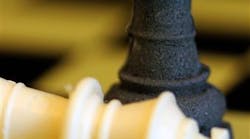A fully degradable bioplastic isolated from shrimp shells was developed by researchers at Harvard's Wyss Institute.
This new material can be used in large-scale manufacturing of everyday objects—from cell phones to food containers and toys, according to researchers.
The bioplastic comes from chitosan, a form of chitin, which is a powerful player in the world of natural polymers and the second most abundant organic material on Earth. Chitin is a long-chain polysaccharide that is responsible for the hardy shells of shrimps and other crustaceans, armor-like insect cuticles, tough fungal cell walls – and flexible butterfly wings.
The majority of available chitin in the world comes from discarded shrimp shells and is either thrown away or used in fertilizers, cosmetics, or dietary supplements, for example. However, material engineers have not been able to fabricate complex 3-D shapes using chitin-based materials—until now.
"There is an urgent need in many industries for sustainable materials that can be mass-produced," said Don Ingber, founding director of the Wyss Institute. "Our scalable manufacturing method shows that chitosan, which is readily available and inexpensive, can serve as a viable bioplastic that could potentially be used instead of conventional plastics for numerous industrial applications."
The Wyss Institute team, led by Inger and Postdoctoral Fellow Javier Fernandez, Ph.D., developed a new way to process the material so that it can be used to fabricate large, 3D objects with complex shapes using traditional casting or injection molding manufacturing techniques. This chitosan bioplastic breaks down when returned to the environment within about two weeks, and it releases rich nutrients that efficiently support plant growth.
"You can make virtually any 3D form with impressive precision from this type of chitosan," said Fernandez, who molded a series of chess pieces to illustrate the point.
The material can also be modified for use in water and also easily dyed by changing the acidity of the chitosan solution. And the dyes can be collected again and reused when the material is recycled.
The next challenge is for the team to continue to refine their chitosan fabrication methods so that they can take them out of the laboratory, and move them into a commercial manufacturing facility with an industrial partner.












